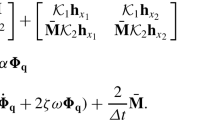Abstract
Finite differences of various orders are used in linear estimation when the measurements contain not only fluctuation noise but also piecewise-continuous interference of degree type.
Similar content being viewed by others
References
A. N. Tikhonov and M. V. Ufimtsev, Statistical Processing of Experimental Results [in Russian], Izd. MGU, Moscow (1988).
Yu. V. Linnik, The Least-Squares Method and the Principles of Mathematical Observation Processing [in Russian], Fizmatgiz, Moscow (1962).
Yu. P. Pyt’ev, Experiment Analysis and Interpretation Methods [in Russian], Izd. MGU, Moscow (1990).
V. A. Leonov and B. K. Poplavskii, Tekhnich. Kibernet., No. 2, 73 (1990).
V. A. Leonov and B. K. Poplavskii, Tekhnich. Kibernet., No. 1, 163 (1992).
Yu. G. Bulychev and I. V. Burlai, Avtometr., 39, No. 1, 69 (2003).
N. G. Nazarov, Basic Concepts in Mathematical Models in Metrology [in Russian], Vysshaya Shkola, Moscow (2002).
A. A. Samarskii and A. V. Gulin, Numerical Methods [in Russian], Nauka, Moscow (1989).
Additional information
__________
Translated from Izmeritel’naya Tekhnika, No. 4, pp. 16–21, April, 2006.
Rights and permissions
About this article
Cite this article
Bulychev, Y.G., Eliseev, A.V. & Lapsar’, A.P. A finite-difference method of improving dynamic measurement accuracy. Meas Tech 49, 332–340 (2006). https://doi.org/10.1007/s11018-006-0111-y
Received:
Issue Date:
DOI: https://doi.org/10.1007/s11018-006-0111-y




